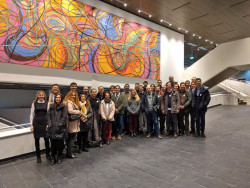Energy efficiency’s ‘best kept secret’ delights district renovation experts
Situated in the dynamic and industrial Rhein-Necker region, Ludwigshafen sits on the banks of the river Rhine, opposite neighbour Mannheim and northwest of Heidelberg. Collectively, the region is known for strong manufacturing, engineering and its inland port, as well as an international hub for IT-services. But above all, Ludwigshafen is also home to BASF and the largest integrated chemical facility in the world. The 10 square kilometre site, employees over 39,000 people in more than 200 facilities and host’s global research and administrative headquarters. The industry, engineering and innovation across the skyline are clearly deep local traits; and Ludwigshafen is developing an excellent program of energy-oriented city refurbishment. The city also took a pioneering stance, joining Climate Alliance in 1995, committing to the Covenant of Mayors in 2011 and a targeted program of climate protection and mobility measures. So what’s the secret? Well, local companies such as BASF have used their extensive local stock of around 3000 apartments and partnerships to test and refine cutting edge insulation and energy efficiency techniques for years – reducing CO2 emissions across a significant number of apartments by 70-80%. All of these proprietary innovations have been rigorously monitored, analysed and improved using over ten years of detailed data sets. The results are an outstanding insight into not just energy performance and renovation paybacks, but also a deep awareness of user behaviour and acceptance, including responsiveness to education sessions with inhabitants. BASF’s Wohnen & Bauen program – literally translated ‘building and living’ – has used their energy and insulation technologies to create a heritage-protected residential complex in the Hohenzollern-Höfe district of Ludwigshafen with an annual average energy consumption of 3 litres of heating oil per square meter of living space. An even more efficient 1-litre series of terraced housing and ‘zero heating cost’ houses have continued to refine technical, economic and human factors even further. Wohnen & Bauen architects and engineers have applied their magic to a large stock of housing; from stylish refurbishments of historical buildings to 1950’s retrofitting and new open concept and green urban living. Members of the CITyFiED were able to discover this lesser-known story of energy efficiency with a detailed overview of monitoring data and guided visits of multiple sites. Local energy supplier TWL kept the interest very high with a tour of a recently built power-to-heat plant. It uses excess energy from wind power stations to avoid shutting turbines or solar power stations in case of grid overload. The impressive combined heat and power storage is put to a multitude of uses to power back residential homes and industry as it needs it. The impressively compact and ingenious power plant will soon also have a 24,000 cell 9 Megawatt battery to add to its toolkit. The range and quality of initiatives continued with a visit to the Miró-clad Wilhelm-Hack museum, subject of an energy efficiency renovation conducted with a passion any artist would be proud of. Excessive energy bills kick-started an innovative set of works – from targeted lighting systems, all the way through to a thief-proof heating and cooling system able to respect precise temperature and humidity needs of the canvas. Energy bills are now just a quarter of their previous cost and emissions and air quality greatly improved. Read more:
Keywords
smart cities, retrofitting, heating
Countries
Germany



